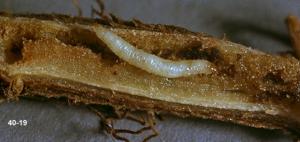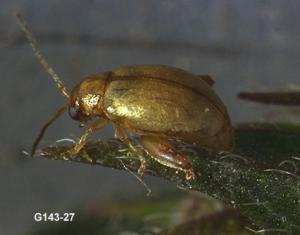|
MINT FLEA BEETLE MANAGEMENT |
|||
|
Return to: |
Mint flea beetle continues to be a pest in central and
western Oregon in the spring. This is the time of year when root damage caused by the
larvae of the mint flea beetle can readily be seen. Spring regrowth of mint injured by
this pest is slow and characterized by spotty stands and reddish plants that are stunted
and stressed. These symptoms are also typical of other factors, such as water stress or
damage from symphylans, root weevils, or nematodes. To sample for larvae, begin taking soil samples in late May
and early June or after 500 to 600 degree-days have been accumulated. Take a minimum of 25
samples per field. Every 1 to 2 acres take a 5 by 7 inch sample of soil and roots to a
depth of 4 inches. This can be done with a small shovel or hollow metal core sampler. Soil
samples can be screened in the field or placed in Berlese funnels to collect the larvae
(see Morris, 1990 and Shields et al., 1981). If you are using
Berlese funnels, we recommend separating the soil and rhizomes to enhance recovery of
larvae. In the field, carefully inspect the soil and roots for small cream-colored larvae
from 1 to 2 mm long with brown heads. They can be found in black or brown
"tracks" within tissue just below the surface of the root. Occasionally they
will be in the soil near the root, or protruding from the root itself. An average of 0.5
to 1.0 larvae per sample may cause injury to mint (Morris, 1990). Spring applications (late May or early June) of parasitic nematodes at a rate of 3.0 billion juvenile nematodes per acre may provide control of mint flea beetle third instar larvae, prepupae, pupae, and teneral adults. Applications should be made in the evening through sprinkler irrigation after soil temperatures exceed 60ºF in the spring and after about 750 degree-days have been accumulated (Morris, 1990). Early spring applications may not be effective because of cold soil temperature, small size of larvae, and their concealment in rhizomes. In areas East of the Cascade Mountains, cool spring temperatures and the lack of adequate irrigation water in the spring may prevent the usefulness of early spring applications. See also the information about using parasitic nematodes to control strawberry root weevil and mint root borer. |


